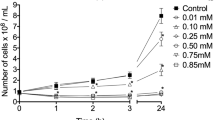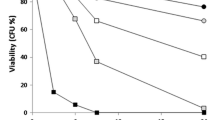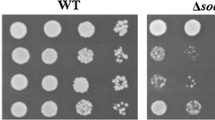Abstract
Lawsone is a natural naphthoquinone present in the henna leaf extract with several cytotoxic activities and used as precursor for synthesis of various pharmaceutical compounds. Its biological activities are thought to be the result of oxidative stress generated, although the hydroxy group at position C-2 in its structure tends to reduce its electrophilic potential. In view of lack of knowledge on its activity, the present work aimed to elucidate the biological effect of lawsone using the yeast Saccharomyces cerevisiae. In the model strain BY4741 it was defined 229 mmol/L as the minimal inhibitory concentration (MIC). Using 172 mmol/L as sub-MIC value it was observed that yap1 deletion mutant was sensitive to lawsone independent the presence of oxygen. Lawsone affected yeast growth in glycerol, indicating interference in the respiratory metabolism. Intracellular content of thiol groups did not indicate intensive oxidative stress and the presence of the anti-oxidant N-acetylcysteine (NAC) exacerbated lawsone toxicity. By analysing the sensitivity of atg mutant strains and the localization of GFP-Atg8 fusion protein, it was concluded that lawsone primarily produces mitochondrial malfunctioning, leading to indirect oxidative stress. It triggers the autophagic response that ultimately induces mitophagy.







Similar content being viewed by others
References
Anaissi-Afonso L, Oramas-Royo S, Ayra-Plasencia J, Martín-Rodríguez P, García-Luis J, Lorenzo-Castrillejo I, Fernández-Pérez L, Estévez-Braun A, Machín F (2018) Lawsone, juglone, and β-lapachone derivatives with enhanced mitochondrial-based toxicity. ACS Chem Biol 13:1950–1957
Budovskaya YV, Stephan JS, Reggiori F, Klionsky DJ, Herman PK (2004) The Ras/cAMP-dependent protein kinase signalling pathway regulates an early step of the autophagy process in Saccharomyces cerevisiae. J Biol Chem 279:20663–20671
Cheong H, Klionsky DJ (2008) Dual role of Atg1 in regulation of autophagy-specific PAS assembly in Saccharomyces cerevisiae Autophagy 4:724–726
Dananjaya SHS, Udayangani RMC, Shin SY, Edussuriya M, Nikapitiya C, Lee J, De Zoysa M (2017) In vitro and in vivo antifungal efficacy of plant based lawsone against Fusarium oxysporum species complex. Microbiol Res 201:21–29
Deffieu M, Bhatia-Kissová I, Salin B, Galinier A, Manon S, Camougrand N (2009) Glutathione participates in the regulation of mitophagy in yeast. J Biol Chem 284:14828–14837
Demasi AP, Pereira GA, Netto LES (2006) Yeast oxidative stress response. Influences of cytosolic thioredoxin peroxidase I and of the mitochondrial functional state. FEBS J 273:805–816
Elsztein C, Lucena RM, de Morais Jr, MA (2011) The resistance of the yeast Saccharomyces cerevisiae to the biocide polyhexamethylene biguanide: involvement of cell wall integrity pathway and emerging role for YAP1. BMC Mol Biol 12:38
Evans P, Halliweell B (2001) Micronutrients: oxidant/antioxidant status. Br J Nutr 85:67–74
Feng Y, He D, Yao Z, Klionsky DJ (2014) The machinery of macroautophagy. Cell Res 24:24–41
Foury F (1997) Human genetic diseases: a cross-talk between man and yeast. Gene 195:1–10
Frei B, Higdon JV (2003) Antioxidant activity of tea polyphenols in vivo: evidence from animal studies. J Nutr 133:3275–3284
Gaisne M, Bécam A-M, Verdière J, Herbert JC (1999) A ‘natural’ mutation in Saccharomyces cerevisiae strains derived from S288c affects the complex regulatory gene HAP. (CYP1). Curr Genet 1:36, 195–200
Grant CM, Maclver FH, Dawes IW (1997) Glutathione synthetase is dispensable for growth under both normal and oxidative stress conditions in the yeast Saccharomyces cerevisiae due to an accumulation of the dipeptide y-glutamylcysteine. Mol Biol Cell 8:1699–1707
Hennicke F, Grumbt M, Lermann U, Ueberschaar N, Palige K, Böttcher B, Jacobsen ID, Staib C, Morschhäuser J, Monod M, Hube B, Hertweck C, Staib P (2013) Factors supporting cysteine tolerance and sulfite production in Candida albicans. Eukaryot Cell 12:604–613
Herrero E, Ros J, Belli G, Cabiscol E (2008) Redox control and oxidative stress in yeast cells. Biochem Biophys Acta 1780:1217–1235
Hosokawa N, Sasaki T, Iemura S, Natsume T, Hara T, Mizushima N (2009) Atg101, a novel mammalian autophagy protein interacting with Atg13. Autophagy 7:973–979
Huang E, Klionsky DJ (2002) Autophagy in yeast: a review of the molecular machinery. Cell Struct Funct 27:409–420
Kamada Y, Funakoshi T, Shintani T, Nagano K, Ohsumi M, Ohsumi Y (2000) Tor-mediated induction of autophagy via an Apgl protein kinase complex. J Cell Biol 150:1507–1513
Kanki T, Klionsky DJ (2009) Atg32 is a tag for mitochondria degradation in yeast. Autophagy 5:1201–1202
Kanki T, Furukawa K, Yamashita S (2015) Mitophagy in yeast: molecular mechanisms and physiological role. Biochim Biophys Acta 1853:2756–2765
Kijanska M, Dohnal I, Reiter W, Kaspar S, Stoffel I, Amerer G, Kraft C, Peter M (2010) Activation of Atg1 Kinase in autophagy by regulated phosphorylation. Autophagy 6:1168–1178
Klaus V, Hartmann T, Gambini J, Graf P, Stahl W, Hartwig A, Klotz L (2010) 1,4-Naphthoquinones as inducers of oxidative damage and stress signaling in HaCaT human keratinocytes. Arch Biochem Biophys 496:93–100
Kuge S, Jones N, Nomoto A (1997) Regulation of yAP-1 nuclear localization in response to oxidative stress. EMBO J 16:1710–1720
Kurtyka R, Pokora W, Tukaj Z, Karcz W (2016) Effects of juglone and lawsone on oxidative stress in maize coleoptile cells treated with IAA. AoB Plants 8:plw073
Knorre DA, Sokolov SS, Zyrina AN, Severin FF (2016) How do yeast sense mitochondrial dysfunction? Microbial Cell 3:532–539
Laxman S, Sutter BM, Tu BP (2013) Methionine is a signal of amino acid sufficiency that inhibits autophagy through the methylation of PP2A. Autophagy 10:386–387
Lee E, Seo EY, Kwon Y, Ha H (2011) Rapid and reliable measurement for evaluating directly the reactivity of N-acetylcysteine with glucose degradation products in peritoneal dialysis fluids. Anal Chem 83:1518–1522
Lee MB, Carr DT, Kiflezghi MG, Zhao YT, Kim DB, Thon S, Moore MD, Li MAK, Kaeberlein M (2017) A system to identify inhibitors of mTOR signalling using high-resolution growth analysis in Saccharomyces cerevisiae. GeroScience 39:419–428
Mahal K, Ahmad A, Schmitt F, Lockhauserbäumer J, Starz K, Pradhan R, Padhye S, Sarkar FH, Koko WS, Schobert R, Ersfeld K, Biersack B (2017) Improved anticancer and antiparasitic activity of new lawsone Mannich bases. Eur J Med Chem 126:421–431
Mahkam M, Nabati M, Kafshboran HR (2014) Isolation, IDentification and characterization of lawsone from henna leaves powder with soxhlet technique. Iran Chem Commun 2:34–38
Nair U, Thum M, Klionsky DJ, Krick R (2011) GFP-Atg8 protease protection as a tool to monitor autophagosome biogenesis. Autophagy 7:1546–1550
Nanji T, Liu X, Chew LH, Li FK, Biswas M, Yu ZQ, Lu S, Dong MQ, Du LL, Klionsky DJ, Yip CK (2017) Conserved and unique features of the fission yeast core Atg1 complex. Autophagy 13:2018–2027
Okamoto K, Kondo-Okamoto N, Ohsumi Y (2009) Mitochondria-anchored receptor Atg32 mediates degradation of mitochondria via selective autophagy. Dev Cell 17:87–97
Pradhan R, Dandawate P, Vyas A, Padhye S, Biersack B, Schobert R, Ahmad A, Sarkar FH (2012) From body art to anticancer activities: perspectives on medicinal properties of Henna. Curr Drug Targets 13:1777–1798
Raftos JE, Whillier S, Chapman BE, Kuchel PW (2007) Kinetics of uptake and deacetylation of N-acetylcysteine by human erythrocytes. Int J Biochem Cell Biol 39:1698–1706
Rahmoun NM, Boucherit-Otmani Z, Boucherit K, Benabdallah M, Villemin D, Choukchou-Braham N (2012) Antibacterial and antifungal activity of lawsone and novel naphthoquinone derivatives. Médecine et Maladies Infectieuses 42:270–275
Rahmoun N, Boucherit-Otmani Z, Boucherit K, Benabdallah M, Choukchou-Braham N (2013) Antifungal activity of the Algerian Lawsonia inermis (henna). Pharmacol Biol 51:131–135
Ramos–Pérez C, Lorenzo-Castrillejo I, Quevedo O, García-Luis J, Matos-Perdomo E, Medina-Coello C, Estévez-Braun A, Machín F (2014) Yeast cytotoxic sensitivity to the antitumour agent β-lapachone depends mainly on oxidative stress and is largely independent of microtubule- or topoisomerase-mediated DNA damage. Biochem Pharmacol 92:206–219
Santos MMS, Elsztein C, De Souza RB, Paiva SSL Jr, Silva JA, Crovella S, De Morais Jr MA (2018) Respiratory deficiency in yeast mevalonate kinase deficient may explain MKD-associate metabolic disorder in humans. Curr Genet 64:871–881
Semwal RB, Semwal DK, Combrinck S, Cartwright-Jones C, Viljoen A (2014) Lawsonia inermis L. (henna): ethnobotanical, phytochemical and pharmacological aspects. J Ethnopharmacol 155:80–103
Shintani T, Klionsky DJ (2004) Cargo proteins facilitate the formation of transport vesicles in the cytoplasm to vacuole targeting pathway. J Biol Chem 279:29889–29894
Sjödin K, Nilsson E, Hallberg A, Tunek A (1989) Metabolism of N-acetyl-L-cysteine: some structural requirements for the deacetylation and consequences for the oral bioavailability. Biochem Pharmacol 38:3981–3985
Sugiyama K, Kawamura A, Izawa S, Inoue Y (2000) Role of glutathione in heat-shock-induced cell death of Saccharomyces cerevisiae. Biochem J 352:71–78
Tachibana T, Okazaki S, Murayama A, Naganuma A, Nomoto A, Kuge S (2009) A major peroxiredoxin-induced activation of Yap1 transcription factor is mediated by reduction-sensitive disulfide bonds and reveals a low level transcriptional activation. J Biol Chem 284:4464–4472
Temple MD, Perrone GG, Dawes IW (2005) Complex cellular responses to reactive oxygen species. Trends Cell Biol 15:319–326
Yao Z, Delorme-Axford E, Backues SK, Klionsky DJ (2015) Atg41/Icy2 regulates autophagosome formation. Autophagy 11:2288–2299
Acknowledgements
The authors are grateful to Prof. Daniel Klionsky, University of Michigan (USA), for kindly providing atg mutants and GFP-Atg8 fusion construction and to Prof. Andrea Harand, Federal University of Pernambuco (UFPE, Brazil) for the use of fluorescence microscopy. Chemical analyses were performed at the Analytical Centre of the Department of Fundamental Chemistry (UFPE, Brazil). This work was supported with grants from the Brazilian funding agencies FACEPE (project APQ-1452-2.01/10) and CNPq (project 472533/2013-4) and by the research support program of the Federal University of Pernambuco (project 23076.021846/2012-47). MRX and MGQ received master and PhD scholarship supports from CAPES agency and MMOL/LSS received PhD scholarship support from FACEPE agency.
Author information
Authors and Affiliations
Corresponding author
Ethics declarations
Conflict of interest
All authors declare that they have no conflict of interest.
Additional information
Publisher's Note
Springer Nature remains neutral with regard to jurisdictional claims in published maps and institutional affiliations.
Electronic supplementary material
Below is the link to the electronic supplementary material.
Rights and permissions
About this article
Cite this article
Xavier, M.R., Santos, M.M.S., Queiroz, M.G. et al. Lawsone, a 2-hydroxy-1,4-naphthoquinone from Lawsonia inermis (henna), produces mitochondrial dysfunctions and triggers mitophagy in Saccharomyces cerevisiae. Mol Biol Rep 47, 1173–1185 (2020). https://doi.org/10.1007/s11033-019-05218-3
Received:
Revised:
Accepted:
Published:
Issue Date:
DOI: https://doi.org/10.1007/s11033-019-05218-3




